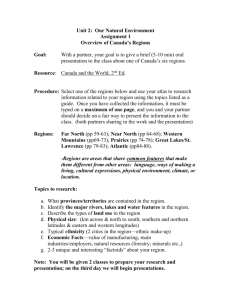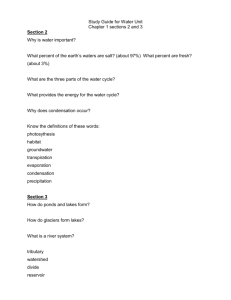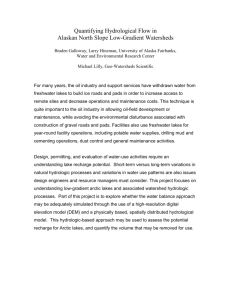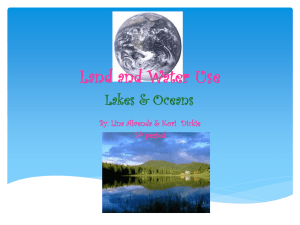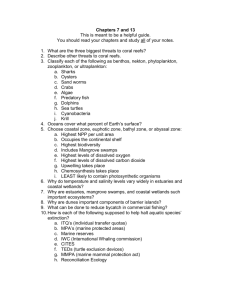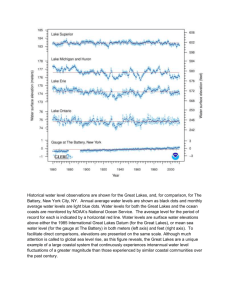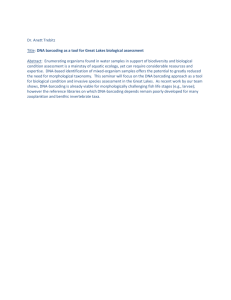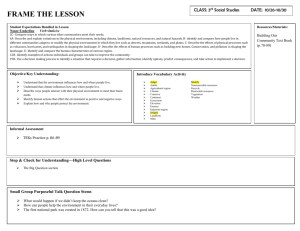The 2007 National Lakes Assessment Steve Paulsen
advertisement
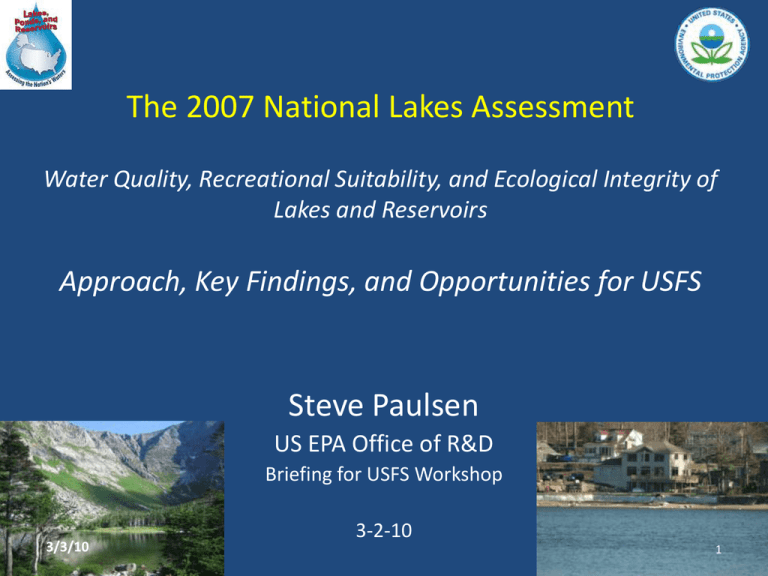
The 2007 National Lakes Assessment Water Quality, Recreational Suitability, and Ecological Integrity of Lakes and Reservoirs Approach, Key Findings, and Opportunities for USFS Steve Paulsen US EPA Office of R&D Briefing for USFS Workshop 3/3/10 3-2-10 1 Purpose of this Presentation • Introduce National Aquatic Resource Surveys • Provide findings of the first NARS survey of lake water quality. • Highlight approach and opportunities for USFS. 3/2/10 USFS Lakes Workshop 2 National Aquatic Resource Survey Initiative Program of recurring national-scale aquatic resource surveys Report on the condition of the Nation’s waters using resource-specific surveys that occur once every five years Probability Design to ensure unbiased representativeness Meets CWA goal to report attainment status of all waters Partnership with States, Tribes and Federal Agencies Five water resource types Flowing waters (streams & rivers), lakes, wetlands, coastal estuaries Promote State and Tribal capacity for monitoring and assessment Opportunity for state-scale surveys Opportunity for Federal Land Management Agencies Opportunity for Specific Subpopulations of Interest New monitoring approaches and assessment tools Promote consistency in cross-jurisdictional assessment of water quality 3/2/10 USFS Lakes Workshop 3 NARS Survey Field Campaigns • • • • • • • 2004 – Wadeable Streams Assessment 2007 – National Lakes Survey 2008 – Nat. Rivers Streams Survey 1/2 2009 – Nat. Rivers Streams Survey 2/2 2010 – Nat. Coastal Assessment (3rd) 2011 – Nat. Wetlands Assessment 2012 – National Lakes Survey 3/2/10 USFS Lakes Workshop 4 National Lakes Assessment Report on the condition of the Nation’s Lakes Statistically valid design that represents the condition of all lakes (similar to stratified random sample) Regional and national estimates of the condition of lakes, option for State-scale estimates or other subpopulations (e.g. National Forests) Use consistent sampling and analysis procedures to ensure the results can be compared across the country Numerous regional and state-scale assessments added to NLA (R 10 states, R 1 States, Prairie Pothole Region, VT, NH, OK, MI, MN, WI 3/2/10 USFS Lakes Workshop 5 Partnerships within the NLA • States carried out sampling and/or interacted with Regions and contractors • Steering Committee of state lakes program staff • Coordinated outreach of survey design, data analysis approaches, and results via North American Lake Management Society • Design, Analysis, coordinated by ORD Western Ecology Division (Corvallis, OR) 3/2/10 USFS Lakes Workshop 6 National Lakes Assessment - Effort • • • • • 1,152 unique lakes sampled (lower 48) Over 16,000 sites “evaluated” Over 3,600 crew person-days Over 640,000 survey measurements Data analysis team comprised of OWOW, ORD, OST, and Regional scientists. 3/2/10 USFS Lakes Workshop 7 National Lakes Assessment Indicators • Biological Integrity • Recreational Condition – Risk of cyanotoxin exposure – Index of Taxa Loss – Occurrence of microcystin – Enterococci – Index of Biotic Integrity • Chemical Integrity • Habitat Integrity – Chlorophyll-a – – – – – – Littoral/Riparian Complexity Phosphorus Nitrogen Transparency Anions, Cations ANC – Littoral habitat quality – Riparian zone integrity – Shoreline disturbance • Stressor Identification 3/2/10 USFS Lakes Workshop 8 All Data Backed by Cumulative Distribution Functions Regional ANC Trends in LTM Network 100 90 Cumulative Percent 80 70 60 50 40 30 New England Lakes Adirondacks Lakes Appalachian Streams Upper Midwest Lakes Ridge and Blueridge Streams 20 10 0 -4 -2 0 2 4 6 Slope of Trend ANC(µeq/L/yr) 8 10 Biological condition of the nation’s lakes 3/2/10 USFS Lakes Workshop 10 Trophic condition of the nation’s lakes 3/2/10 USFS Lakes Workshop 11 Habitat integrity of the nation’s lakeshores 3/2/10 USFS Lakes Workshop 12 Stressors to biological integrity of the nation’s lakes Rel. Extent: Percent of lakes in poor condition Rel. Risk: Likelihood that biological integrity is poor when stressor is poor 3/2/10 USFS Lakes Workshop 13 Trends: Sediment diatoms and Nat. Eutro. Survey Based on sediment diatom inferences, 12% of lakes are improving, and 7% are degrading. Using the NESNLA comparison, 20% of NES lakes have improved, while 16% have degraded. 3/2/10 USFS Lakes Workshop 14 National Lakes Assessment: Report Intro and design Change over time National Findings Ecoregional Findings Uses of the NLA Results Future challenges –2012 Region VT NAP US (48) 0.0 10.0 20.0 30.0 40.0 50.0 60.0 Proportion of lakes 3/2/10 OLIGOTROPHIC (≤ 2 ug/L) MESOTROPHIC (>2-7 ug/L) EUTROPHIC (>7 to 30 ug/L) HYPEREUTROPHIC (> 30 ug/L) USFS Lakes Workshop 15 Opportunities for USFS • Simply use NLA findings for comparison to FS data • Enhance sample size in NLA for subpopulations of interest to FS: – Geographic subpopulations – e.g. lakes on FS land; high elevation western lakes – Specific types of problems – e.g. lakes sensitive to acidification 3/2/10 USFS Lakes Workshop Lakes Sampled in NLA USFS Land Lakes on USFS Lands Source: NHD+ Lower 48 >1–4 12,584 >4 - 10 5,668 >10 - 50 3,709 >50 – 100 521 >100 – 500 480 >500 – 5,000 87 >5,000 3/2/10 23,051 2 Eastern US 10,541 Western US 12,510 Western US < 5,000ft 2,765 Western US > 5,000ft 9,745 Condition of USFS Lakes Estimates from NLA 3/2/10 Biological Quality 55.83 Nation 21.38 22.35 75.2 FS - National 21.7 2.4 92.2 FS - East 4.9 1.8 49.4 FS - West 47.2 3.2 0 20 40 60 80 100 Percentage of Lakes Taxa Loss 3/2/10 > 40% 20 - 40% < 20% Nutrients Total Phosphorus 58.1 Nation 23.7 18.2 69.9 FS - National 20.5 9.6 73.9 FS - East 24.2 1.9 63.8 FS - West 14.8 21.4 0 20 40 60 80 100 Percentage of Lakes 3/2/10 Most Disturbed Intermediate Least Disturbed Physical Habitat Littoral Habitat and Riparian Veg Complexity 46.8 Nation 20.1 32.4 53.4 FS - National 20.6 24.8 47.2 FS - East 31.4 20.2 62.8 FS - West 4.2 31.8 0 20 40 60 80 100 Percentage of Lakes 3/2/10 Most Disturbed Intermediate Least Disturbed Special Interest Subpopulation Acidification The TIME and LTM Projects: Monitoring to Assess Regulatory Effectiveness for Acidification 3/2/10 Clean Air Act Amendments of 1990 Goal of Title IV: “reduce the adverse effects of acid deposition through reductions in annual emissions of sulfur dioxide of ten million tons from 1980 emission levels, and of nitrogen oxides emissions of approximately two million tons from 1980 emission levels” 3/2/10 Acidification Status, 1990 (results from National Surface Water Survey, 1985-88) 3/2/10 Acid Sensitive Regions - LTM All sites deliberately chosen – most have data since 1983 Calcium + Magnesium (µeq/L) Nitrate (µeq/L) Sulfate (µeq/L) Darts Lake (Adirondacks) 180 160 140 120 100 80 80 60 40 20 0 160 140 120 100 80 ANC (µeq/L) 20 0 -20 -40 1/1/82 1/1/84 1/1/86 1/1/88 1/1/90 1/1/92 1/1/94 1/1/96 1/1/98 1/1/00 1/1/02 Date Acid Sensitive Regions - TIME • • • All sites chosen with probability design Northeast lake data since 1991 Mid-Atlantic stream data since 1993 Alkalinity Trends in TIME/LTM Regions Regional ANC Trends in LTM Network 100 90 Cumulative Percent 80 70 60 50 40 30 New England Lakes Adirondacks Lakes Appalachian Streams Upper Midwest Lakes Ridge and Blueridge Streams 20 10 0 -4 -2 0 2 4 6 Slope of Trend (µeq/L/yr) 8 10 Changes in Populations since CAAA Region Population Size Number Acidic1 % Acidic2 Time Period of Estimate Current Rate of ANC change3 Estimated Number Currently Acidic Current % acidic % Change in Number of Acidic Systems New England 6,834 lakes 386 lakes 5.6% 1991-94 +0.3 374 lakes 5.5% -2% Adirondacks 1830 lakes 238 lakes 13.0% 1991-94 +0.8 149 lakes 8.1% -38% No. Appalachians 42,426 km 5,014 km 11.8% 1993-94 +1.0 3,393 km 7.9% -32% Ridge/Blue Ridge 32,687 km 1,634 km 5.0% 1987 -0.0 1,634 km 5.0% 0% Upper Midwest 8,574 lakes 251 lakes 2.9% 1984 +1.0 80 lakes 0.9% -68% Number of lakes/streams with Gran ANC<0 in past probability survey (data collected at “Time Period of Estimate”, in column 5) 2 Percent of population (from Column 2) with Gran ANC<0 in past probability survey (data collected at “Time Period of Estimate”, in column 5) 3 Based on regional trends presented in this report, in µeq/L/year 1 Regional Trends in TIME/LTM Regions Broadly, in surface waters of glaciated terrain : SO42– decreased at a rate of –2.5 µeq/L/yr NO3– decreased at a rate of –0.5 µeq/L/yr Sum of these changes sets an upper limit to our expectation of ANC recovery of +3 µeq/L/yr Gran ANC increase is actually about 1/3 of this, +1 µeq/L/yr Difference almost entirely explained by regional declines in base cations; average regional median decline in [Ca2+ + Mg2+] = -1.8 µeq/L/yr Major Conclusions 1. Large regional declines in surface water sulfate – unquestionably due to CAAA 2. Regional “recovery” (increase in ANC) in two regions with largest proportions of acidic surface waters (Adirondacks, Appalachian Plateau) 3. Ridge and Blue Ridge provinces continue to show lagged response – and no recovery 4. Key uncertainties make prediction of future difficult – base cations, nitrate, organic acids Conclusions from Presentation • NLA provides opportunity for cross agency collaboration • ~ $10M of data available for comparison to FS systems • Opportunities are there – just requires discussion • Timing is right – just starting 2012 lake survey planning Recreational condition of the nation’s lakes 3/2/10 USFS Lakes Workshop 36 National Lakes Assessment: Significant Advances • First-ever national-scale assessment of lakes of this scale. • National IBI based on sediment diatoms • National Taxa Loss model based on plankton • National perspective on extent of microcystin occurrence • Consistent assessment of habitat condition • Support evaluation of nutrient criteria recommendations for lakes 3/2/10 USFS Lakes Workshop 37 Significant finding – littoral and habitat degradation • The finding that littoral and riparian habitat alterations are the most important stressors to biological integrity is consequential. • Opportunity exists to leverage NLA findings to promote mitigation of cumulative lakeshore impacts at the national, state, and even local level. • Professional lake community is eager for nationalscale findings to support state-scale initiatives to protect lakeshores. 3/2/10 USFS Lakes Workshop 38
